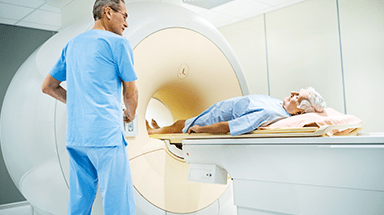Screenings & Exams
Doctors may recommend a PSA blood test and a digital rectal exam if you have a family history of prostate cancer.
Learn more about screenings.UPMC Hillman Cancer Center is part of the UPMC family.

Explore this Section
Prostate cancer is the most common cancer in men. There are approximately 192,280 new prostate cancers cases in the U.S. each year.
Prostate cancer is a malignant tumor of the prostate gland. The prostate is a walnut-sized organ located in front of a man's rectum and below the bladder.
Prostate cancer usually grows slowly, so chances for successful treatment increase if doctors catch the disease early. Your age and the stage of the cancer will help determine your treatment. For some men, doctors recommend active surveillance — closely monitoring the tumor — instead of treatment.
The prostate gland is part of the male reproductive system. It produces some of the fluids in semen, which help keep sperm alive and healthy. The muscles in the prostate also help push semen out of the body when you ejaculate.
Factors that may increase prostate cancer risk:
In the early stages, prostate cancer has few symptoms. Most men find out they have it through screening. Symptoms of later-stage disease may include:
To diagnose prostate cancer, a doctor my perform a digital rectal exam and order a prostate-specific antigen (PSA) blood test. While these tests may indicate a problem with the prostate, a doctor will order a transrectal ultrasound and transrectal biopsy to confirm.
Other diagnostic tests may include:
Learn more about diagnostic tests used to diagnose and stage prostate and other urologic cancers:
If your doctor diagnoses you with prostate cancer, they will run tests to see if the disease has spread, and how far. The main stages of prostate cancer are I through IV. The higher the stage, the more serious the cancer is.
Learn more about prostate cancer from the National Cancer Institute.
To learn more about prostate cancer care or to make an appointment, you can:

Screenings & Exams
Doctors may recommend a PSA blood test and a digital rectal exam if you have a family history of prostate cancer.
Learn more about screenings.
Prostate Treatment Program
UPMC Hillman Cancer Center employs a multidisciplinary approach to treating prostate cancer that includes state-of-the-art, evidence-based treatment options.
Learn more about our treatment program.
Treatments for Prostate Cancer
Our oncologists offer a full range of treatments, including traditional and minimally-invasive surgery, medical oncology options and radiation therapy.
Read more about treatment options.